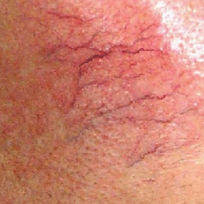Thermocoagulation utilizes the high frequency current to discharge pinpoint heat energy to produce a thermal lesion and the immediate disappearance of the imperfections and spider veins while preserving the epidermis. All that may remain is a tiny circular red mark that disappears within hours post-treatment to leave a micro-crust which itself disappears usually within a few days. The treatment is extremely safe and unlike other procedures does not pose risk of heat blistering or scarring.
SKIN TAG REMOVAL
Skin tags are harmless growths that can appear anywhere on your skin, but often develop on the neck, eyelids, underarms or beneath the breasts. Skin tags are very common and are usually small and harmless. They may be the same colour as your skin or darker.
Sensation: Mild discomfort, like a slight stinging or snapping sensation. Topical Anesthetic can be used beforehand to minimize any sensation. Treated area may be sensitive for a short time afterward, with some tingling sensation.
Downtime: A scab may form. Avoid picking at the scab, as this can increase the risk of scarring. The area should be kept clean and dry. Healing typically occurs within a few days. Some minor scarring or temporary changes in skin colour are possible, these are usually not noticeable to others and often fade over time.
Result: Smooth, clear skin with no imperfections.
15-minute sessions (1-2 skin tags)
30-minute sessions (2-5 skin tags)
45-minute sessions
60-minute sessions
Topical Anesthetic
R500
R750
R950
R1150
R190


FLAT DPNS REMOVAL
Dermatosis Papulosa Nigra (DPN) is a harmless skin condition that tends to affect people with darker skin. The small black, brown or skin-colored bumps are usually smooth, round and flat. Over time, the bumps can become rougher looking. Sometimes the lesions have small flaps attached that look like skin tags.
Depending on the amount and size of the DPNS to be treated, 2 - 3 sessions might be required, two weeks apart.
Sensation: Relatively painless with a slight tingling or pinprick sensation when the electric current is delivered.
Downtime: The treated area will appear slightly grazed and may be red and/or swollen for a few hours post-treatment. It is essential to avoid direct sun exposure during the recovery period. Daily sunscreen application and correct aftercare is essential.
Result: Even skin tone and refined surface appearance.
15-minute sessions
30-minute sessions
45-minute sessions
60-minute sessions
Topical Anesthetic
R500
R750
R950
R1150
R190


VASCULAR LESIONS
The most common cause of telangiectasia is photoaging - aging related to sun exposure. It is also common among people with Rosacea and liver disease. By creating a thermal lesion, thermolysis collapse visible facial veins or capillaries upon contact while preserving the epidermis.
The length and number of treatments, depends on the severity and the number of vascular lesions to be treated on a specific area.
After the procedure you might experience redness, swelling and minor scabbing. These side effects are temporary and typically subsides within a few days to a week. It is essential to avoid direct sun exposure during the recovery period - sunlight can exacerbate redness and delay recovery.
Typically, treatments are spaced 4-6 weeks apart.
Sensation: Relatively painless with a slight tingling or pinprick sensation when the electric current is delivered.
Downtime: After the procedure you might experience redness, swelling and minor scabbing. These side effects are temporary and typically subsides within a few days to a week. It is essential to avoid direct sun exposure during the recovery period - sunlight can exacerbate redness and delay recovery.
Result: The aim is to eliminate the damaged vessels permanently, leading to a reduction or elimination of visible lesions. The treated area will usually fade and lighten over time with results typically appearing within 2 - 6 weeks.
15-minute sessions
30-minute sessions
45-minute sessions
60-minute sessions
R500
R750
R950
R1150


PIGMENTED LESIONS
Sunspots, also known as age spots or liver spots, are common skin changes that often appear as dark, flat areas on the skin. They are caused by long-term sun exposure. Age spots are harmless and should be monitored. If you notice a new brown mark on your skin, it’s a good idea to consult a dermatologist, especially if you are over the age of 50 or have a personal or family history with cancer.
Seborrheic Keratosis is a common non-cancerous skin growth. It can develop in single lesions or clusters. Should they become irritable and bleed, consult with a dermatologist.
15-minute sessions
30-minute sessions
45-minute sessions
60-minute sessions
Topical Anesthetic
R500
R750
R950
R1150
R190


Sensation: Relatively painless with a slight tingling or pinprick sensation when the electric current is delivered.
Downtime: The treated area will appear slightly grazed and may be red and/or swollen for a few hours post-treatment. It is essential to avoid direct sun exposure during the recovery period. Daily sunscreen application and correct aftercare is essential.
Result: Even skin tone and refined surface appearance.
-scale-1.png)


